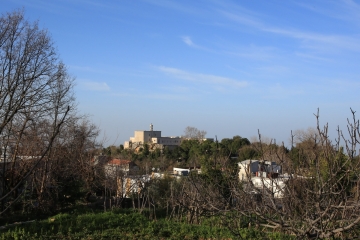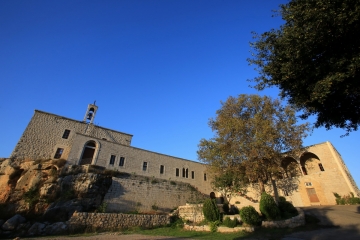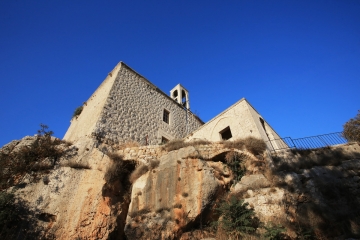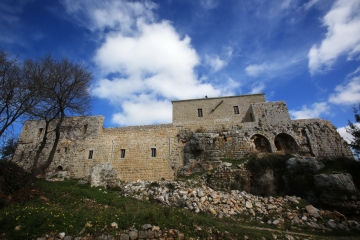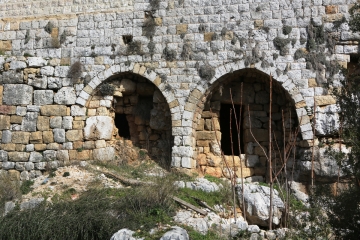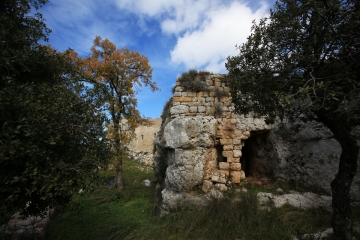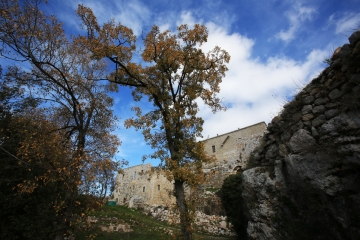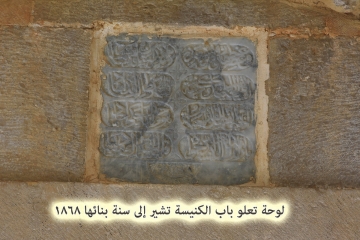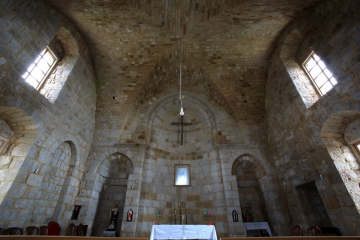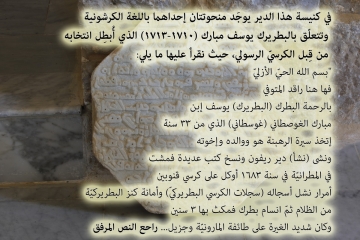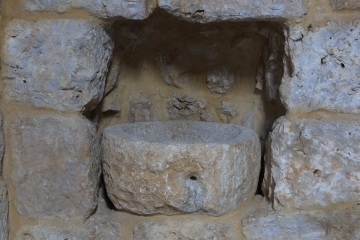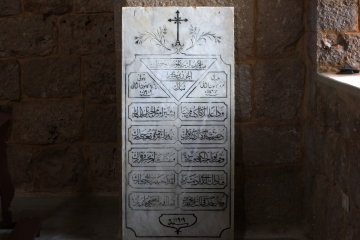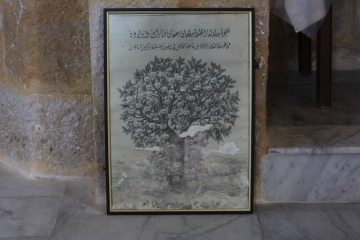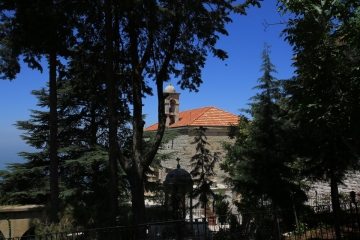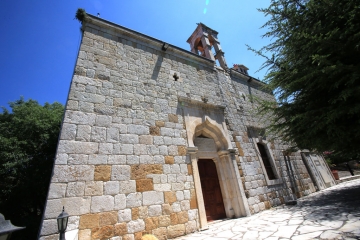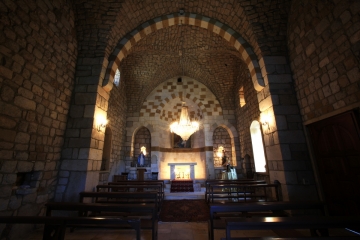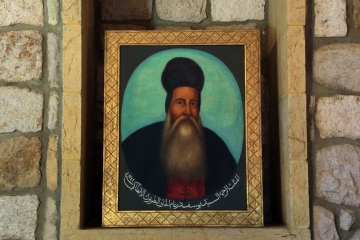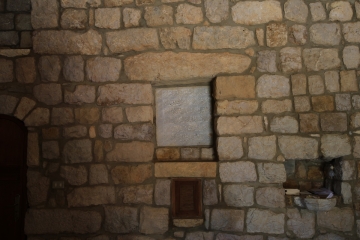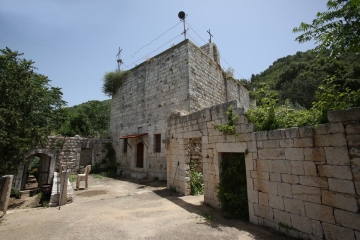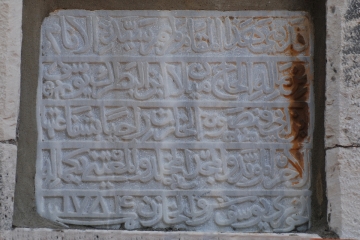دير مار سركيس وباخوس – ريفون
يعود إنشاء دير مار سركيس وباخوس في بلدة ريفون إلى العام 1655. يعني اسم ريفون "مَكان الإستشفاء والراح"، أو، كما ورد في كتاب "المُقاطعة الكسروانية"، إن مَلك مِصر بطليموس الخامس إبتنى لإبنه الرابع رافان، هيكلاً شرقي بلدة عجلتون.. وتُسمَّى مَحَلتَه اليوم ريفون.
بناه القَس سليمان مبارك من غوسطا، الذي كان مُتزوجاً ومُنجِباً لسبعة بنين. ولكنَّ وفاة زوجته كانت صَدمةً قويةً له جَعَلته يأنف من حياة الدُنيا ويَزهَدُ بها، فَقَرَّر مع بنيه إعتزال العالم والسَكن في أحد الأديار، عاكفاً وإياهم على الصلاة والتأمل ومُمارسة الصِيام وسائر إنواع الإماتات.
لم يَبتعدوا في البدء عن مَسقط رأسهم غوسطا، فلجأوا إلى دير مار شلّيطا مقبس وانتموا إلى الجماعة الرهبانية لهذا الدير، وظلّوا فيه مُدة خمس سنوات تَمَرَّسوا خلالها بالحياة الرهبانية وأتقنوا أصولها، كما مارسوا العمل اليدويَّ داخل الدير وخارجه.
ولَعَلّ إنشاء هذا الدير الرهبانيّ كان مُلهِماً للقس سليمان وأبنائه، فقرَّروا بِدورهم تأسيس دير خاص بهم. وهكذا نَزحوا عن دير غوسطا قاصدين قرية ريفون حيث انتقوا تلة صغيرة بينها وبين عجلتون تقوم عليها خِربة هي بقيَّة مَعبدٍ قديم، فبنوا عليها أولاً قبواً عقداً وأقاموا بقربه بعض القلاّيات للسَكن وكنيسةً صغيرة جَعلوها على اسم القدّيسَين الشهيدَين سركيس وباخوس. ثم سَنّوا لأنفسهم نظاماً رهبانياً صارماً قوامه الصلوات السَبع يومياً، والإنقطاع عن الزَّفَر وعمّا تشتهيه النفس من أنواع الأطايب. وثابروا هناك على العمل اليدويّ الذي إعتادوا عليه في دير مار شلّيطا، وذلك في الجنائن والحقول القريبة من ديرهم الجديد. فاستَصلَحوا الأراضي تمهيداً لزراعتها، واهتمّوا بغرس الأشجار، والكروم، والشتول، مِمّا كان يعود عليهم بالنفع ويساعدهم في تأمين عيشهم.
وهكذا أصبحت العائلة المؤلفة من ثمانية أشخاص: الأب وأبنائه السَبعة، عائلة رهبانية بكاملها مُنقطعة للنسك والتقشف والصلاة، إلى أن توفي الوالد عام 1713 كما يَشهَد إعلان منقوش على بلاطة ضريحه في الدير. وهناك نَقش آخر يُشير إلى أن الكنيسة التي بجوار الدير والتي حَمِلت اسم القدّيسَين سركيس وباخوس قد بُنيت في العام 1717.
الأبناء تابعوا سيرة والدهم وسيرتهم في عهده، حتى أن ثلاثةً منهم إرتقوا إلى الدرجة الأسقفية، أولهم جبرائيل الذي كان أول أسقف على أبرشية بعلبك، وثانيهم يوسف الذي تَعيَّنَ مطراناً على أبرشية صيدا إثر وفاة راعيها المطران بطرس الإهدني، وهو الذي انتقاه مجمع المطارنة بطريركاً بديلاً من البطريرك المعزول زوراَ يعقوب عواد (1705-1733)، فَظَلَّ في تدبير شؤون البطريركية مدة ثلاث سنوات إلى أن حَكَم الكرسيّ الرسولي بإرجاع البطريرك عواد إلى كرسيّه، مُبطلاً انتخاب البطريرك مبارك، فتوفي هذا الأخير بعد فترةٍ قصيرة من ذلك، وقيل لنه قضى ألماً وتَحسُّراً على إبطال انتخابه بطريركاً. أما الثالث من هؤلاء الأساقفة الثلاثة فكان المطران جبرائيل الثاني الذي تَعيَّن على أبرشية صيدا وتوفي عام 1733.
وفضلاً عن الإخوة الثلاثة المذكورين، طلع من هذه العائلة "المباركة" أسقفان آخران هما المطران جبرائيل مبارك الثالث الذي كان من رهبان دير مار سركيس وباخوس، والمطران بطرس مبارك الذي كان من رهبان القديس فرنسيس قبل إرتقائه إلى الدرجة الأسقفية.
تَحوّل هذا الدير سنة 1831 إلى مَدرسة عمومية للطائفة المارونية، واستمر كمدرسة عمومية عشرات السنين...وفي الحرب العالمية الثانية استعملته السُلُطات الفرنسية المُنتدبة، مُعتقَلاً لِمَن تعتبرهم معادين لفرنسا في الحرب، أو من رعايا إحدى الدول المُعادية، فَفَرضَت الإقامة الجبرية فيه على الشيخ يوسف الخازن الذي كان مُنحازاً لإيطاليا، وعلى مدير مدرسة الاخوة المريميين في جونية ذي الأصل الايطالي ويُدعى الأخ جوزيف لوي. وفي أحداث العام 1975 وما بعده، إستُعمِلَ في البداية كملجأ للمُهجَّرين، ثم تمّ استعماله من قِبَل الاحزاب... حتى بداية التسعينات حيث تحوَّل إلى مركز عسكري للجيش.
وفي شهر آب من العام 2008 قدَّمت البطريركية المارونية الدير لمؤسسة كاريتاس لإقامة مخيّمات صيفية ودورات تدريبية فيه، وما زال حتى اليوم برعاية كاريتاس التي تقوم بإعادة ترميمه وتأهيله، وتقيم فيه مخيمات للشبيبة ودورات تثقيفية ورياضات روحية.
إلى هذا الحَدّ من التعريف بدير مار سركيس وباخوس وبُناته وساكنيه، لا يتبيَّن لنا سبب اعتباره مقرّاً بطريركياً.. خلا إقامة البطريرك يوسف مبارك فيه الذي لم يُعتبر انتخابه شرعياً.
ولكنَّ بطريركاً آخر، مُثبَّتاً من الكرسيّ الرسولي ونائلاً الصِفة الشرعية، سَكَن في هذا الدير، وهو البطريرك يوسف ضِرغام الخازن (1733-1742) الذي لُقِّب بـ "بطريرك المَحدَلة" لكونه، لدى اجتماع الاساقفة في هذا الدير لانتخاب بطريرك خلفاً للبطريرك يعقوب عواد المُتوفّى، اختلفوا على شخص البطريرك الذي يُريدونه ولم تَفصُل القرعة في خِلافهم، فَعَدَلوا عن مُتابعة الانتخاب وهَمّوا بالرجوع كل إلى مَقرّه، وإذ خرجوا من الدير صادفوا المطران الخازن جالساً على مَحدَلة فوق سَطح الفرن القريب، فراح يلومهم على خِلافهم، ويَحِثَهم على العودة واستئناف عملية الانتخاب مُختارين مَن يرون فيه الكفاءة والأهلية، موحّدين صفوفهم وقلوبهم. فأثَّر فيهم كلامه، ورأوا من خلال ما وعظهم به انه الأجدر بِتَولّي المَنصِب البطريركيّ. فأجمعوا على انتخابه، وهكذا انتقل من الجلوس على المحدلة إلى الجلوس على السدَّة البطريركية. جاء ما ورد اعلاه في دراسة للأب بولس صفير، حافظ المكتبة البطريركية سابقاً وابن عجلتون جارة ريفون.
هذا البطريرك وُلد على اسم ضِرغام، وهو إبن فيّاض المَعروف بـ "أبي قانصوه" وحَفيد أبو نوفل الخازن. عُرف بِرجولته حَيثُ كانت الناس تَهابَه وتَحتَرِمه، وإشتُهر على الأخَص، عندما أوفدَه شقيقه حُصن إلى قَنّوبين، بعد أن بلغه خبر الإهانة التي لَحِقَت بالبطريرك الدويهي، وذلك بالاعتداء الذي جرى عليه من قِبَل الحكام الحَماديين، فذهب إلى قَنّوبين مع نسيبيه الشيخ موسى والشيخ نادر على رأس قوةٍ كما ذكرنا عن ذلك تفصيلاً لدى حديثنا عن البطريرك الدويهي.
ونَنقُل في ما يلي عن كتاب "الجامع المفصّل في تاريخ الموارنة المؤصّل" للمطران يوسف الدبس أن ضِرغام كان مُتزوجاً وله ولد دُعي ميلان، ولكن شاءت الظروف أن تُتوفى زوجته، فَقَرَرَّ على الأثر الإلتحاق راهباً بدير مار سركيس وباخوس في ريفون.. مُتخذاً اسم يوسف في الكهنوت.
وتعود علاقة هذا البطريرك، المولود في غوسطا، بدير مار سركيس وباخوس إلى ما قبل انتخابه بطريركاً. فهو قد لَبِس إسكيمه الرهبانيَّ فيه، وفيه كذلك رُقّي إلى الدرجة الأسقفية من قِبَل البطريرك يعقوب عواد (1705-1733) وعُيّن مطراناً فخرياً على غوسطا، وفيه انتُخب بطريركاً في 24 شباط 1733، ونال دِرع التثبيت من البابا كليمنت الثاني عشر (1730-1740) عام 1734.
وبالمناسبة نَذكُر ان هذا البطريرك هو الأول من ثلاثة بطاركة من العائلة الخازنية، والثاني منهم كان طوبيا قيس الخازن (1756-1766)، والثالث يوسف راجي الخازن (1845-1854).
اهتمَّ هذا البطريرك بالتعليم، فأنشأ ما بين 1734 و 1735 مَدرَسة عينطورة في كسروان ومَدرَسة في زغرتا. كما استقدم الرهبان اليسوعيين إلى لبنان، وأسَّس دير مار يوسف ليكون مركزاً لهم في جبل لبنان، وتابع سِياسة التَحالُف مع فرنسا. وأهمّ أحداث عَهدِه كانت عقد المَجمَع اللبناني عام 1736 كما ورد في ما سبق، الذي أقرَّ نظاماً داخلياً للكنيسة، وَحَدَّد صلاحيات البطريرك، واستحدث أبرشيات جديدة وألزم الأساقفة بالسكن فيها، كما نَظَّم الرهبانيات وكذلك الأوقاف لأجل إدارة مُمتلكات الكنائس، وكُبرى أعماله كانت إقرار التعليم المجاني الإلزامي للفتيان والفتيات. كما أنه نظَّم العلاقة بين البطريرك والبابا بحيث ألزم البطريرك بإستشارة كرسيّ روما في الأمور الكَنَسية الخطيرة، وقد صَدَرَت في أعقاب هذا المجمع النسخة الثالثة من كتاب القِداس الماروني سنة 1763.
والمُلفِت للنَظَر أن هذا المَجمَع، الذي عُقد برئاسة بطريرك خازنيّ، قد ألغى إمتياز مشاركة الأعيان، ومنهم الخازنيون، بانتخاب البطريرك، وذلك من أجل حُسن تنظيم الشوؤن الدينية والإجتماعية، وكذلك ألغى حق الخازنيين بتسمية مطارنة كلٍ من أبرشيات بعلبك ودمشق وحلب.
ومقابل هذه الإمتيازات التي نُزِعت عن أعيان الموارنة تَمَّ الإتفاق مع الكرسي البطريركي بأن يقوم مشايخ بيت الخازن، نيابةً عن باقي الأعيان، بِحِراسة أبواب المَقَرّ الذي يجري فيه انتخاب بطريرك جديد، على أن يقوم بهذه الحراسة شيخان، أحدهُما يكون لزاماً من مشايخ آل الخازن في غوسطا، بلدة البطريرك يوسف ضرغام، والثاني لزاماً من مشايخ آل الخازن في عجلتون...
لكنَّ هذا البطريرك، رغم انتخابه في دير مار سركيس وباخوس، وإقامته فيه أحياناً ووفاته فيه يوم 13 ايار 1742، لم يُدفن في هذا الدير، بل نُقل جُثمانه إلى مَسقِط رأسه غوسطا ودُفِنَ في كنيسة مار الياس الحيّ التي تعود لعائلته آل الخازن، والتي كان قد حَوّلها إلى كرسيٍّ لأسقفيته حين كان مطراناً على غوسطا.
وهذه الكنيسة كان قَد تَمَّ تجديدها في العام 1689 من قِبل الشيخ فيّاض إبن الشيخ نادر الخازن (أبو نوفل)، كما تَدُل اللوحة المَنحوتة الكائنة فوق مَدخلِها. أمّا في الداخل فهُناك لوحة تؤرِّخ وفاة البطريرك مُثْبَتة على الحائط الشمالي وعليها نقشٌ باللغة العربية وآخر باللغة اللاتينية.. مع تواريخ بالارقام الرومانية هذا نصها:
رَوَت ثرا ألم كبير يا مولى قضى بالله مسرورا بوجه مازن
أن قيل من هذا وما تاريخه فالبطريرك الشهم يوسف خازن.
كان انتقال هذا الأب النبيل مار يوسف البطريرك إبن المرحوم الشيخ فياض الخازن من دار الشقا إلى دار النياح والبقا في اليوم الثالث عشر من شهر أيار سنة ١٧٤٢ مسيحيّة وقد جلس على الكرسي الأنطاكي تسع سنين وسبعة أشهر فكان عابداً متواضعا جداً تغمّده الله رحمته واسكنه فسيح جنّاته.
Joseph Pet. Patriar Antiog
Milan Gazen EIUS FIL. IN MEM
OBIIT DIE XIII MAI AN .D. MDCCXXXXII
وهذه اللوحة تُخلّد ذكرى وفاة البطريرك يوسف درغام الخازن بتاريخ 13 ايار 1742، وذلك ببادرة من نجله ميلان.
كذلك يوجد في الكنيسة لوحة زيتية للبطريرك تحمل العبارة التالية: المثلث الرحمة السيد يوسف درغام الخازن البطريرك الأنطاكي ١٧٤٢
والجدير بالذِكر أن ميلان هذا، نَجل البطريرك، يروي عنه المطران ناصر الجميّل، في كتابه "وثائق رهبانية" -الجزء الثاني- ما يلي: "يَعود إنشاء دير بقلوش – ساحل علما إلى العام 1780، يوم أوقفَ الشيخ ميلان ضرغام الخازن، ابن البطريرك يوسف ضِرغام، بطريرك "المَجمَع اللبناني"، كلَّ ما يَملِكَه لإنشاء دير على اسم السيّدة العذراء في منطقة بقلوش...".
وبعد وفاته خلّد الخوري يوسف شَرَف الخازن تاريخ التأسيس على لوحة رخامية عُلقت فوق باب الكنيسة وتحمل الكتابة التالية:
"قد بنى هذا المقام لمريم سيّدة الأنام
من ماله، الحاج ميلان إبن البطريرك يوسف
إبن أبي قانصوه الخازن، راجياً بشفاعتها
الأجر المؤبّد والمَجد المعتني بكماله
الخوري يوسف شَرف الخازن سنة 1781".
وبالعودة إلى دير ريفون، تَجدُر الإشارة إلى ان أحداثاً هامة جرت فيه. ذلك أن المَشهور تاريخياً إن "المَجمَع اللبناني" الذي نجم عنه وضع دستور للطائفة المارونية انعَقدَ في دير سيّدة اللويزة، ولكنَّ الحقيقة إن بداياته كانت في دير ريفون الذي نتحدث عنه.
فلدى وصول القاصِد الرَسوليّ يوسف سِمعان السِمعاني موفداً من قِبَل البابا كليمنت الثاني عشر (1730-1740) ليترأس هذا المجمع، نُوديَ أولاً بإنعقاده في دير سيّدة قنّوبين، ولَكِنَّ لمّا كان يَتعذَّر على كثيرين الذهاب إلى قَنّوبين بسبب والي طرابلس وجيوشه والإضطرابات في منطقة الشمال، فقد قرَّ الرأي على عقد المَجمَع في كسروان. إنما اختلفت الآراء حول مكان الاجتماع، فبعضهم آثر أن يكون في دير سيّدة اللويزة، والبعض الآخر فَضَّل دير مار سركيس وباخوس في ريفون.
فأبدى البطريرك يوسف ضرغام الخازن، واقرباؤه المشايخ، رغبتهم بأن تُعقد الجلسات الأولى الإبتدائية في دير ريفون الذي اعتاد البطريرك ان يُقيمَ فيه، ولَكِنَّ بعد أن بدأت الجلسات، حَصَل خلاف بين البطريرك وبَعض الأساقفة حول بعض المسائل، ولمّا تعذَّر البتُّ النهائيّ بها وحَصَل هيجان من جانب اقرباء البطريرك.. إضطُرَّ آباء المَجمَع للانتقال إلى دير سيّدة اللويزة لإكمال المَجمَع بعيداً عن المُنازعات. فأصدر البطريرك أمراً بإستئناف أعمال المَجمَع في دير سيّدة اللويزة، فإستؤنف هناك، وصَدَرَت عنه المُقرَرات التي كان من جُملتها تعيين دير مار سركيس وباخوس في ريفون مقرّاً لأساقفة أبرشية بعلبك.
وبهذا الصَدَد نَذكُر ما أورده الأباتي بطرس فهد في أحد مقالات سِلسِلته التي كان ينشرها في مجلة "المَشرِق" تحت عنوان "الأديار القديمة في كسروان" إذ قال: "من الحوادث المُهمَّة التي جرت في عهد الرئيس السابع (على دير ريفون) القَس فرنسيس مبارك.. الدعوى التي جَرَت بين مشايخ آل الخازن وبين بيت مبارك بداعي حق الولاية على دير ريفون. فَحَكَم أولاً مَجمَع اللويزة سنة 1818 بحَق الولاية لآل الخازن، لكنَّ بيت مبارك رفعوا الدعوى إلى الكرسيّ الرسولي، فأعيد النظر في الدعوى وحُكم لهم سنة 1826. ثم إستؤنفت الدعوى، وطالت المُخابرات في ذلك أمام القاصدَين الرسوليَّين لويس غندلفي ويوحنا لوزانّا والسيّدين البطريركين يوسف حبيش وغريغوريوس بطريرك الأرمن الكاثوليك وكثير من الأساقفة والقضاة الكنسيين. فتولّوا فَحص الدعوى، وراجعوا كل الصُكوك والحِجَج، وطلبوا شِهادات العارفين، ورفعوا تقاريرهم إلى الكرسيّ الرسولي الذي أثبت بوجهٍ نهائيّ حُكمَه لبيت مبارك في رسالة مَطوَّلة بتاريخ 9 حزيران سنة 1832، نَسختها الأصلية موجودة في مكتبة القصادة الرسولية، وقد بلَّغ السيّد لوزانّا إلى الفريقين هذا الحكم في 12 آب سنة 1833".
أمّا الحدث الهامّ الثاني الذي عرِفه هذا الدير، فكان تحويله إلى مدرسة، فهو قد بقي مقرّاً لسكن أساقفة بعلبكّ مئة سنة ونيّفاً، أي من سنة 1710 حتى سنة 1831، ولمّا ارتقى البطريرك يوسف حبيش (1823-1845) إلى السدَّة البطريركية عام 1823 اهتمَّ بتحويل بعض الأديار إلى مدارس عمومية للطائفة؛ وهكذا تحوَّل دير مار عبدا هرهريّا إلى مدرسة سنة 1830، ثم دير مار سركيس وباخوس سنة 1831. وبالجُملة أصبحت المدارس الإكليريكية المارونية في عهد البطريرك يوسف حبيش (1823-1845) أربعة، وهي مدرسة عين ورقة، ومدرسة مار عبدا هرهريّا، ومدرسة مار سركيس وباخوس في ريفون، ومدرسة مار جرجس- الرومّية في القليعات.
وقد جَدَّد الخوري فرنسيس مبارك الثاني، رئيس مدرسة مار سركيس وباخوس، بناء المدرسة.. وزاد عليها كنيسةً جميلة، وتوفي سنة 1872.
وفي كنيسة هذا الدير يوجَد منحوتتان إحداهما باللغة الكرشونية وتتعلّق بالبطريرك يوسف مبارك (1710-1713) الذي أُبطِل انتخابه من قِبل الكرسيّ الرسولي كما ذكرنا آنفاَ، حيث نقرأ عليها ما يلي:
"بسم الله الحيّ الأزليّ
فها هنا راقد المتوفي
بالرحمة البطرك (البطريرك) يوسف إبن
مبارك الغوصطاني (غوسطاني) الذي من 33 سنة
إتخذ سيرة الرهبنة هو ووالده وإخوته
ونشى (نشأ) دير ريفون ونسخ كتب عديدة فمشت
في المطرانيّة في سنة 1683 أوكل على كرسي قنوبين
أمرار نشل أسجاله (سجلات الكرسي البطريركيّ) وأمانة كنز البطريركيّة
من الظلام ثمّ انسام بطرك فمكث بها 3 سنين
وكان شديد الغيرة على طائفة المارونيّة وجزيل
الرحمة على الكهنة والرهبان ثم رقد
بالرب في ديره المذكور بحضور المطارنة
والمشايخ الخوازنة أولاد أبو نوفل
وأولاد أبو قانصوه وأولاد أبو
آصاف الميت منذ 18 أيلول
سنة 1713 ربّانيّة".
وأخرى باللغة العربية نُقش عليها ما يلي:
في عصر غبطة مار بولس مسعد مَن باسمه كل الورى
لبّى النداء مباركٌ فأقامها فخراً فرنسيس الرأس الاعظم
أحيى بها الفضل القديم لآله وهو الفضل "الملونغ" للتقدم
وبناؤها يبدى (يبدا) بتاريخٍ له: "هذا مقامٌ فيه مريمُ تَنْعَمُ"
1868
Saint Sarkis and Bacchus Monastery – Rayfoun
The establishment of the monastery of Mar Sarkis and Bacchus in Rayfoun dates back to 1655. Its name means “the place of healing and rest”. As stated in the book “The Keserwan District,” King Ptolemy V of Egypt possibly built for his fourth son, Ravan, a temple east of the town of Ajaltoun. Today, its locality is Rayfoun.
It was built by Reverend Suleiman Mubarak of Ghosta, who was married and had seven sons. The death of his wife, however, was a great shock to him, and made him resent worldly life and renounce it. He decided with his sons to retire from the world and live in a monastery, and they all devoted their lives to prayer, meditation, and fasting.
At first, they did not move away from their hometown of Ghosta, so they moved to the monastery of Mar Shalita Moqbes and joined the monastic group of this monastery. They remained there for five years, during which they practiced the monastic life and perfected it at the hands of its devout monks. They also did manual work inside and outside the monastery.
Perhaps life at this monastery was an inspiration to Pastor Suleiman and his sons, so they decided, in turn, to establish their own monastery. Thus, they left the monastery of Ghosta and headed to the village of Rayfoun, where they chose a small hill remained the ruins of an ancient temple. They first built an arched vault on it and built a small cellar near it for housing, as well as a small church they named after the martyred saints Sarkis and Bacchus. They then organized for themselves a strict monastic system consisting of the seven daily prayers and abstention from all worldly pleasures. They resumed the manual labor they were accustomed to in the Mar Shallita monastery, in the gardens and fields near their new monastery. They reclaimed the lands in preparation for their cultivation and took care of planting trees, vines, and seedlings, which would benefit them and help them secure their livelihood.
Thus, the family, consisting of eight people, the father and his seven sons, became entirely a monastic family, living in asceticism, austerity and prayer, until the father died in 1713, as evidenced by a declaration inscribed on the slab of his tomb in the monastery. Another inscription indicates that the church next to the monastery, which bears the name of Saints Sarkis and Bacchus, was built in 1717.
The sons followed in the footsteps of their father until three of them were promoted to the episcopal rank, the first of whom was Gabriel, who was the first bishop of the diocese of Baalbek, and the second of whom was Joseph, who was appointed bishop of the Diocese of Sidon following the death of Bishop Boutros al-Ehdeni. The latter was chosen by the Metropolitan Synod as an alternative patriarch to the falsely deposed Patriarch Youssef Awwad (1705-1733) and managed the affairs of the Patriarchate for three years until the ruling of the Holy See to return Patriarch Awad to his throne, nullifying the election of Patriarch Mubarak. The latter died shortly afterward, and it was said that he had passed away full of pain and regret over the invalidation of his election as Patriarch.
The third of these three bishops were Archbishop Gabriel II, who was appointed to the Diocese of Sidon and died in 1733.
In addition to the three mentioned brothers, two other bishops emerged from this "blessed" family: Archbishop Gabriel Mubarak III, who was a monk of the monastery of Saint Sarkis and Bacchus, and Metropolitan Boutros Mubarak, who was one of the monks of St. Francis before his elevation to the episcopal rank.
In 1831, this monastery was transformed into a public school for the Maronite community, and it continued to serve as a public school for dozens of years. During the Second World War, the French mandated authorities used it to detain those they considered hostile to France and they imposed house arrest in it on Sheikh Youssef al-Khazen, who was allied with Italy, and the director of the Marian Brothers School in Jounieh, who was of Italian origin. His name was Brother Joseph Lowe. When the civil war broke out in 1975 and thereafter, it was initially used as a shelter for the displaced, then used by different parties until it was turned into a military center for the army in the nineties.
In August 2008, the Maronite Patriarchate presented the monastery to the Caritas Foundation and allowed it to set up summer camps and training courses in it, and it is still under the auspices of Caritas, which is restoring and rehabilitating it, setting up youth camps, educational courses, and spiritual workshops.
This is all the available information about the monastery of Saint Sarkis and Bacchus, its construction, and its residents. The reason for considering it a patriarchal seat is not clear, and can only be justified by the residence of Patriarch Youssef Mubarak in it, even though his election was not considered legitimate.
However, another patriarch, confirmed by the Holy See and obtaining legal status, resided in this monastery. It was Patriarch Youssef Dargham al-Khazen (1733-1742), who was nicknamed “Patriarch of the roller” because, at the meeting of bishops in this monastery, held to elect the successor of the deceased Patriarch Jacob Awad, they couldn’t agree on a name, and neither could the lottery settle their dispute. They decided to return each to his seat and, as they were leaving the monastery, they met the Archbishop Khazen sitting on a roller on the roof of the nearby furnace. He blamed them for their disagreement and urged them to resume the election process, choosing whom they saw fit and competent, uniting their ranks and their hearts. His words had an impact on them, and they saw through what he preached to them that he was the worthiest of the patriarchal position. They unanimously elected him, and thus he moved from sitting on a roller to sitting on the patriarchal seat. The above came in a study by Father Paul Sfeir, the former patriarchal library keeper who hailed from Ajaltoun, the neighbor of Rayfoun.
This patriarch was born under the name of Dargham, the son of Fayyad, known as "Abi Qansouh" and the grandson of Abu Nofal al-Khazen. He was known for his manliness, and people feared and respected him, and he became famous especially when his brother Hisn sent him to Qannoubine after he heard the news of the insult inflicted on Patriarch Douaihy, and the attack on him by the Hammadid rulers. He went to Qannoubine with his cousins Sheikh Musa and Sheikh Nader at the head of an armed force, as we mentioned in detail when we talked about Patriarch Douaihy.
Bishop Youssef Al-Dibs wrote that Dergham was married and had a son called Milan, but as fate would have it, his wife died, so he decided to join the monastery of Saint Sarkis and Bacchus in Rayfoun, become a monk, and take the name Joseph in priesthood.
The relationship of this patriarch, who was born in Ghosta, to the monastery of Mar Sarkis and Bacchus goes back to before his election as patriarch. He wore his monastic robes in it, and in it, he was also promoted to the episcopal rank by Patriarch Yacoub Awad (1705-1733), as well as appointed honorary bishop of Ghosta before he was elected patriarch on February 24, 1733, and received the confirmation shield from Pope Clement XII (1730-1740) in 1734.
It is noteworthy that this patriarch was the first of three patriarchs of the Khazen family, the second of them being Tobia Qais al-Khazen (1756-1766), and the third being Yusuf Raji al-Khazen (1845-1854).
This patriarch was interested in education and established between 1734 and 1735 a school in Aintoura in Kesrouan and a school in Zgharta. He also brought the Jesuit monks to Lebanon and established the Saint Joseph Monastery as their headquarters in Mount Lebanon, and he maintained the alliance with France. The most important events of his reign were the convening of the Lebanese Synod in 1736, as mentioned in the foregoing, which approved an internal system for the church, determined the powers of the patriarch, created new dioceses and obligated bishops to reside in them, and organized monasteries as well as endowments to manage the properties of churches. This patriarch was interested in education and established between 1734 and 1735 a school in Aintoura in Kesrouan and a school in Zgharta. He also brought the Jesuit monks to Lebanon and established the Saint Joseph Monastery to be their center in Mount Lebanon, and he continued the policy of alliance with France. The most important events of his reign were the convening of the Lebanese Synod in 1736, as mentioned in the foregoing, which approved an internal system for the church, defined the powers of the patriarch, created new dioceses and obligated bishops to reside in them, as well as organized monasteries as well as endowments to manage the properties of churches. His most important endeavor was the establishment of free and compulsory education for boys and girls. He also regulated the relationship between the patriarch and the pope so that the patriarch was obliged to consult the See of Rome in serious ecclesiastical matters. Following this council, the third version of the Maronite Missal was published in 1763.
What is striking is that this Synod, which was held under the chairmanship of a Patriarch from the Khazen family, abolished the privilege of the participation of dignitaries, including the Khazens, in electing the Patriarch, to separate religious and social affairs. It also abolished the right of the Khazens to nominate the archbishops of the dioceses of Baalbek, Damascus, and Aleppo.
In exchange for these privileges that were taken away from the Maronite notables, it was agreed with the Patriarchal See that the elders of the house of Khazen, on behalf of the rest of the notables, guard the doors of the headquarters in which a new patriarch is being elected, provided that two sheikhs undertake this guard, one of whom is mandatorily from the Khazen family in Ghosta. , the town of Patriarch Youssef Dergham, and the second from the Khazen family in Ajaltoun.
However, this patriarch, despite his election in the monastery of Mar Sarkis and Bacchus, and his residence there sometimes and his death there on May 13, 1742, was not buried in this monastery. Instead, his body was transferred to his hometown of Ghosta and was buried in the church of Saint Elias that belonged to his family, the Khazen family, and which he had turned into a chair for his episcopate when he was Metropolitan of Ghosta.
This church was renovated in 1689 by Sheikh Fayyad, the son of Sheikh Nader Al-Khazen (Abu Nofal), as indicated by the carved plaque above its entrance. On the inside, there is a plaque indicating the death of the patriarch installed on the northern wall with an inscription in Arabic and another in Latin, with dates in Roman numerals. The text was an eloge to the late patriarch and indicated the date of his death, and was followed by:
Joseph Pet. Patriar Antiog
Milan Gazen EIUS FIL. IN MEM
OBIIT DIE XIII MAI AN .D. MDCCXXXXII
This plaque commemorates the death of Patriarch Youssef Dergham Al-Khazen on May 13, 1742, at the initiative of his son Milan.
In the church is also an oil painting of the patriarch bearing the following phrase:
“Mercy be upon him, Mr. Youssef Dergham El-Khazen, Patriarch of Antioch 1742”
It is worth noting that Bishop Nasser Gemayel, in his book “Monastic Documents” - Part Two – wrote about Milan, the patriarch’s son, the following: “The establishment of the Baqloush Monastery - Sahel Alma - dates back to 1780, when Sheikh Milan Dargham al-Khazen, son of the Patriarch, donated all his possessions to establish a monastery in the name of the Virgin Mary in the Baqloush area.
After his death, Father Youssef Sharaf Al-Khazen immortalized the date of the foundation on a marble plaque hung above the church door bearing the following inscription
This shrine was built for Mary, the lady of the worlds
With the donation of Milan, the son of Patriarch Joseph
Son of Abi Qansuh al-Khazen, hoping for her intercession
Hers is eternal glory and perfection
The priest Youssef Sharaf Al-Khazen in 1781
Circling back to the Rayfoun monastery, it should be noted that it witnessed important events. The historically famous "Lebanese Synod", which resulted in the drafting of a constitution for the Maronite community, was held in the Monastery of Our Lady of Louaize, but its beginnings were in the Rayfoun Monastery that we are talking about.
Upon the arrival of the Apostolic Nuncio, Youssef Semaan Al-Samani, delegated by Pope Clement XII (1730-1740) to preside over this Synod, he called first for it to convene in the Monastery of Our Lady of Qannoubine. But, because many couldn’t go to Qannoubine because of the governor of Tripoli and his armies and the unrest in the north, it was decided to hold the council in Kesrouan. However, opinions diverged about the meeting place, as some preferred to be in the monastery of Our Lady of Louaize, and others preferred the monastery of Mar Sarkis and Bacchus in Rayfoun.
Patriarch Youssef Dargham Al-Khazen and his relatives the sheikhs expressed their desire that the first primary sessions be held in the Rayfoun monastery, where the Patriarch used to reside; However, after the sessions began, a disagreement occurred between the Patriarch and some bishops over some issues, and when it was not possible to make a final decision on them, the agitation on the part of the Patriarch’s relatives forced The Synod fathers to move to the Monastery of Our Lady of Louaize to resume the Synod away from disputes. The Patriarch issued an order to resume the work of the Synod in the Monastery of Our Lady of Louaize; During that Synod, he made many decisions, including the appointment of the monastery of Mar Sarkis and Bacchus in Rayfoun as the seat of the bishops of the Diocese of Baalbek.
In this regard, we recall what Abbot Boutros Fahd reported in one of the articles of his series that he published in the “Al-Mashreq” magazine under the title “Ancient Monasteries in Kesrouan,” when he said: “One of the important incidents that took place during the reign of the seventh president (at the Rayfoun monastery), Reverend Francis Mubarak, is the lawsuit that took place between the sheikhs of the Al-Khazen family and the Mubarak family on the grounds of the right of guardianship over the Rayfoun Monastery. The Louaize Council first ruled in 1818 for the guardianship to be granted to the Al-Khazen family, but the Mubarak family brought the case to the Holy See; it was reconsidered and a ruling was passed for their benefit in 1826. Then the lawsuit was resumed, and the investigation was prolonged before the Apostolic Nuncio, Louis Gandolfi, John Lusanna, the Patriarchs Youssef Hobeish, and Gregory the Armenian Catholic Patriarch, and many of the bishops and ecclesiastical judges. They examined the case, reviewed all the instruments and arguments, requested the testimonies of witnesses, and submitted their reports to the Holy See, who finally proved its ruling on the House of Mubarak in a lengthy letter dated June 9, 1832, the original copy of which is in the Apostolic Library of Representatives, and Mr. Lusanna communicated this ruling to both parties on August 12, 1833.
The second important event in this monastery was its conversion into a school. It remained the residence of the bishops of Baalbek for more than a hundred years, i.e., from 1710 until 1831. When Patriarch Youssef Hobeish (1823-1845) ascended to the patriarchal seat in 1823, he was interested in converting some monasteries into public schools for the sect; Thus, the monastery of Mar Abda Hararia was transformed into a school in 1830, followed by the monastery of Mar Sarkis and Bacchus in 1831. The Maronite seminary schools during the era of Patriarch Youssef Hobeish (1823-1845) became four, namely, the Ain Waraka School, Mar Abda Hararia School, and Saint Sarkis and Bacchus School in Rayfoun, and Saint George's School - Al-Roumieh in Klayaat.
Father Francis Mubarak II, head of the Saint Sarkis and Bacchus School, renovated the building of the school and added a beautiful church to it. He died in 1872.
In the church of this monastery, there are two sculptures, one of them in the Karshuni language and related to Patriarch Youssef Mubarak (1710-1713), whose election was annulled by the Holy See, as we mentioned above, and it mentions his biography and praises his efforts and endeavors.
